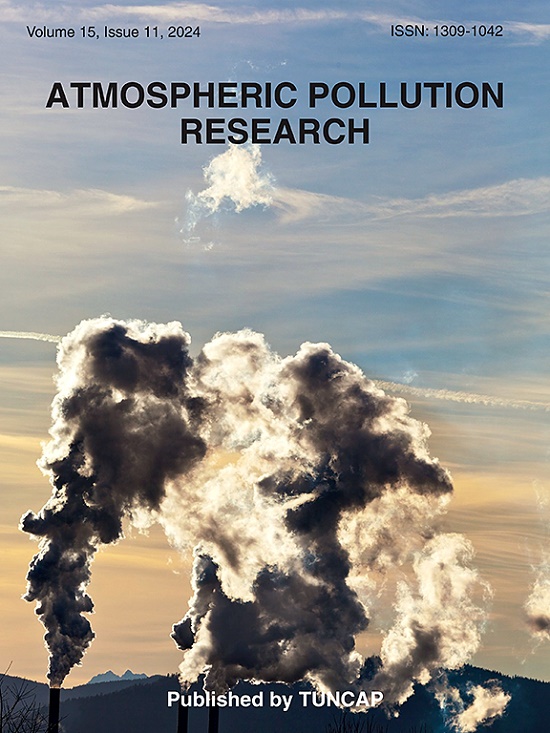基于正矩阵分解(PMF)的细颗粒物时间动态及源特性研究
IF 3.5
3区 环境科学与生态学
Q2 ENVIRONMENTAL SCIENCES
引用次数: 0
摘要
受体模型中数据的时间粒度在识别排放模式和偶发性污染事件方面起着关键作用,而这对于可靠的污染源分摊至关重要。低时间分辨率测量可能会忽略短期变化,从而导致污染源的不完整呈现。本研究利用2019年5月至2020年2月在德里Major Dhyan Chand国家体育场收集的多时间-季节分辨化学成分数据,研究了不同时间分辨率(1小时、2小时、4小时、8小时、12小时和24小时)和不同季节PM2.5的来源特征和贡献。正矩阵因式分解(PMF)确定了所有时间分辨率和季节的八个一致因素:两个固体燃料燃烧源(SFC1 和 SFC2)、一个富 S 源、交通(废气和非废气)、灰尘和三个人为工业/燃烧羽流事件(Cl-Br、Pb-Se 和 Cu-Cd)。对不同时间分辨率下的源剖面和贡献率进行比较后发现,SFC1 在所有季节的时间变化最大,其次是 Cl-Br、交通、Pb-Se 和 Cu-Cd,而富含 S 的因子和粉尘因子则保持相对稳定。受物种混合的影响,源剖面随时间的变化给源识别带来了挑战。利用分歧系数(CoD)进行的敏感性分析表明,源剖面的异质性随着时间分辨率的提高而增加,这表明需要高分辨率数据来捕捉源的动态变化。鉴于这些研究结果,使用高分辨率数据的滚动式 PMF 方法可以通过定期更新源剖面来改善实时源分配,从而更好地反映不断变化的排放源。这项研究强调了高分辨率数据在实现准确的、具有时间分辨率的源分配方面的重要性,这对空气质量管理和政策制定至关重要。本文章由计算机程序翻译,如有差异,请以英文原文为准。

Temporal dynamics and source characteristics of fine particulate matter using Positive Matrix Factorization (PMF)
The temporal granularity of data in receptor models plays a key role in identifying emission patterns and episodic pollution events, which are essential for robust source apportionment. Low-time resolution measurements may overlook short-term variations, leading to an incomplete representation of pollution sources. This study investigated the source characteristics and contributions of PM2.5 across different time resolutions (1-h, 2-h, 4-h, 8-h, 12-h, and 24-h) and seasons, using multi-time-season-resolved chemical composition data collected at Major Dhyan Chand National Stadium in Delhi from May 2019 to February 2020. Positive Matrix Factorization (PMF) identified eight consistent factors across all time resolutions and seasons: two solid fuel combustion sources (SFC1 and SFC2), an S-rich source, traffic (exhaust and non-exhaust), dust, and three anthropogenic industrial/combustion plume events (Cl-Br, Pb-Se, and Cu-Cd). The comparison of source profiles and contributions at different time resolutions revealed that SFC1 exhibited the highest temporal variability across all seasons, followed by Cl-Br, traffic, Pb-Se, and Cu-Cd, while S-rich and dust factors remained relatively stable. The variation in source profiles over time, influenced by species mixing, posed challenges for source identification. A sensitivity analysis using the coefficient of divergence (CoD) showed that heterogeneity in source profiles increased with coarser time resolution, indicating the need for high-resolution data to capture dynamic source variations. Given these findings, a rolling-PMF approach with high-resolution data could improve real-time source apportionment by updating source profiles at regular intervals to reflect ever-changing emissions sources better. This study highlights the importance of high-resolution data in achieving accurate and temporally resolved source apportionment, essential for air quality management and policy development.
求助全文
通过发布文献求助,成功后即可免费获取论文全文。
去求助
来源期刊

Atmospheric Pollution Research
ENVIRONMENTAL SCIENCES-
CiteScore
8.30
自引率
6.70%
发文量
256
审稿时长
36 days
期刊介绍:
Atmospheric Pollution Research (APR) is an international journal designed for the publication of articles on air pollution. Papers should present novel experimental results, theory and modeling of air pollution on local, regional, or global scales. Areas covered are research on inorganic, organic, and persistent organic air pollutants, air quality monitoring, air quality management, atmospheric dispersion and transport, air-surface (soil, water, and vegetation) exchange of pollutants, dry and wet deposition, indoor air quality, exposure assessment, health effects, satellite measurements, natural emissions, atmospheric chemistry, greenhouse gases, and effects on climate change.
 求助内容:
求助内容: 应助结果提醒方式:
应助结果提醒方式:


